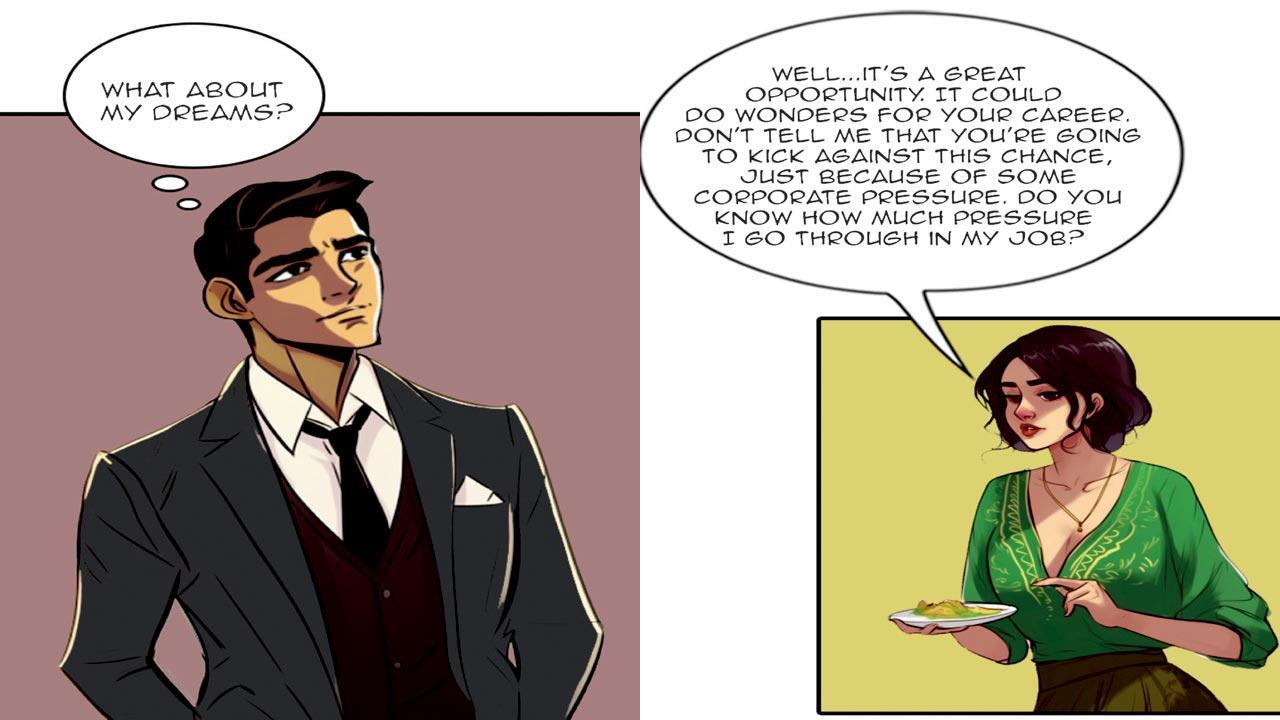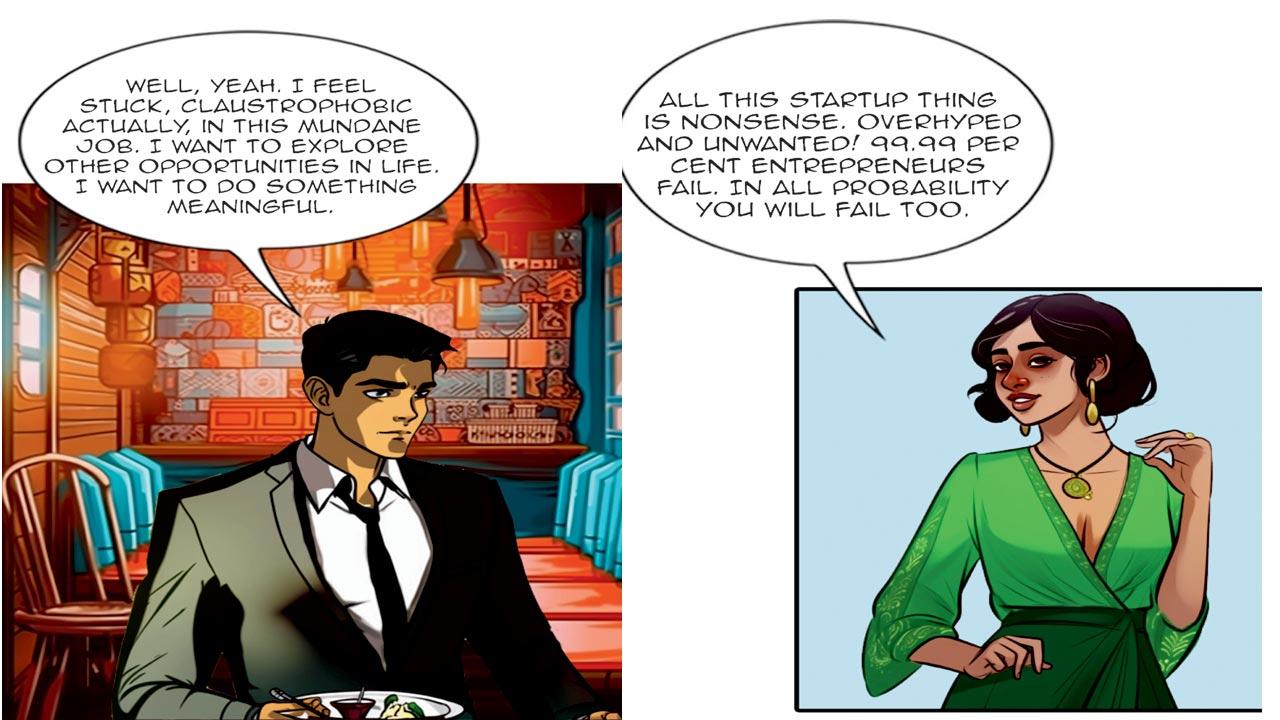Online publishers use the new kid on the tech block to tackle writer’s block and cut down production time. Will it give writers a run for the pun?

Frames from a comic created using Artificial Intelligence. Details about a character’s profile—how s/he looks, age, mood, etc are fed into the character sheet, as well as the script. AI-driven tools then generate episodic panels in accordance with the script, writers review and tweak for nuances such as expression and line of sight. Sixty panels now take two days to execute
An episode that would take 10 days, now takes two days,” says Rajeev Tamhankar, “and it would be 70 to 80 per cent accurate… just needs a little tweaking… maybe the character’s eyes are not looking where they are supposed to, or the expression is wrong.”
The chief content head at Pratilipi Comics is talking about the new Artificial Intelligence (AI)-driven process they have been using on the online self-publishing and audiobook portal that publishes content in 11 regional Indian languages.

They’ve used the new tools—some licensed, some developed in-house—for 10 different comics they publish in Hindi. “Tech is always moving ahead,” says Ranjeet Pratap Singh, CEO and co-founder of Pratilipi, “you can adopt it, or fight it.” Adopting it, they found, did not compromise quality or cut down manpower, but opened up brain space for writers to work on more projects in parallel and work through writer’s blocks with ChatGPT.
“Normally, there is a script and a character sheet,” explains Singh. “In the latter, we feed in profile details of the characters—how s/he looks, age, whether s/he is usually sad, expressions, etc.” Tamhankar adds that they also feed in episode outline and background—say the protagonist, in his/her 30s, is standing on the beach at sunset. The episodic panels are then generated in accordance with the script, which the writer can just review and tweak to perfection.

“It doesn’t replace the storyteller or graphic artist,” Singh clarifies, “It accelerates the process—one episode would need 40 to 60 panels, which could take an artist one week to 10 days to create. Now, it takes one to two days.” It also rids them of the tedium of not working on something they don’t like, “Some artists love drawing backgrounds, but not, say anatomy,” says Tamhankar, “It solves that barrier, also that of having someone to bounce ideas off of. It enhances speed and quality.”
This development, seen against the backdrop of the writers’ strike in the USA, is intriguing. Amidst wage dissatisfaction, the Writers Guild of America has also demanded that artificial intelligence such as ChatGPT be used only to help research or facilitate script ideas, and not to replace them.

Graphic novelist and podcaster Vishwajyoti Ghosh, while clarifying that he is not familiar with the work at Pratilipi, says this is a human reaction to new technology—to play with it and see where it goes. “All forms—AI and human generated—will emerge and the reader will choose,” he says. “The [original] practice will not be eroded, it will be added to. Like how the synthesiser did not replace the flautist or the guitarist.”
Ghosh also points out that the machine is learning against the machine, and hence algorithms are fighting to outdo each other every minute, yet through human effort. “Google is already curtailing AI-driven content,” he says, referring to the search engine’s Search Advocate John Mueller saying categorically that content automatically generated with AI writing tools is considered spam according to the search engine’s webmaster guidelines.
 Ranjeet Pratap Singh, Vishwajyoti Ghosh and Rajeev Tamhankar
Ranjeet Pratap Singh, Vishwajyoti Ghosh and Rajeev Tamhankar
Tamhankar, though, is excited. He holds a PhD in creative writing from IIT Roorkee, has studied narratology and is itching to write AI into the script. One of his research topic was Game of Thrones and he talks about how each character had different archetypes. The Mountain uses the same story device as Mary Shelley’s Frankenstein’s monster. Jaime Lannister throws a child out of the window in the first season, but his character has a redemption act by the end of the series.
“Such set patterns can be integrated with graphics with the use of AI driven tools,” he says, giving examples of feeds such as, “Introverted boy and extroverted girl meet on a train [Jab We Met], or extroverted boy and introverted girl meet on a train [DDLJ] to prod AI to develop story arcs.” It could help recreate these timeless models and is curious as to how it would infuse emotions, which are geography based.
According to Ghosh, this path could create an offshoot of the medium, as memes have diverged from cartooning.“AI is bringing diverse styles on a single platform but that’s nothing new. Various filters and apps have been around. Artists who are working with even little tech are using it to aid them.”
The seed, according to him, is in the confidence that the algorithm can’t get you—it can create a mishmash of images taken from a human-created repository, and whitewash it to give the sensibility of a comprehensive image. “It cannot recreate the depth of human effort,” says the author who ran an experiment on Instagram when he prompted ChatGPT to write like Rabindranath Tagore. “Every designer feels his best design is yet to be made; every writer feels his best book is yet to come. As long as there’s a human urge to create, there will be original content. Both with or without AI...”
 Subscribe today by clicking the link and stay updated with the latest news!" Click here!
Subscribe today by clicking the link and stay updated with the latest news!" Click here!










